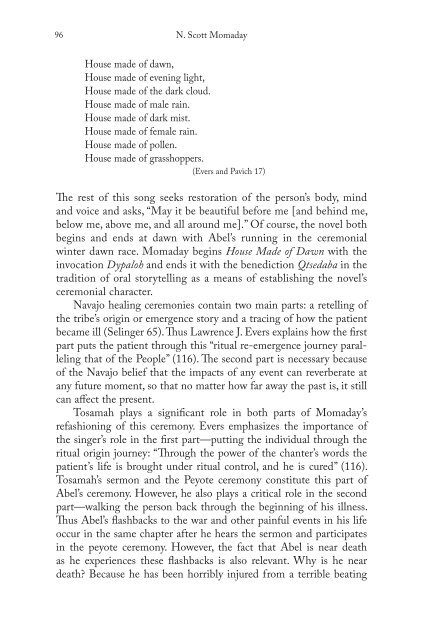Blooms Literary Themes - THE TRICKSTER.pdf - ymerleksi - home
Blooms Literary Themes - THE TRICKSTER.pdf - ymerleksi - home
Blooms Literary Themes - THE TRICKSTER.pdf - ymerleksi - home
You also want an ePaper? Increase the reach of your titles
YUMPU automatically turns print PDFs into web optimized ePapers that Google loves.
96<br />
N. Scott Momaday<br />
House made of dawn,<br />
House made of evening light,<br />
House made of the dark cloud.<br />
House made of male rain.<br />
House made of dark mist.<br />
House made of female rain.<br />
House made of pollen.<br />
House made of grasshoppers.<br />
(Evers and Pavich 17)<br />
Th e rest of this song seeks restoration of the person’s body, mind<br />
and voice and asks, “May it be beautiful before me [and behind me,<br />
below me, above me, and all around me].” Of course, the novel both<br />
begins and ends at dawn with Abel’s running in the ceremonial<br />
winter dawn race. Momaday begins House Made of Dawn with the<br />
invocation Dypaloh and ends it with the benediction Qtsedaba in the<br />
tradition of oral storytelling as a means of establishing the novel’s<br />
ceremonial character.<br />
Navajo healing ceremonies contain two main parts: a retelling of<br />
the tribe’s origin or emergence story and a tracing of how the patient<br />
became ill (Selinger 65). Th us Lawrence J. Evers explains how the fi rst<br />
part puts the patient through this “ritual re-emergence journey paralleling<br />
that of the People” (116). Th e second part is necessary because<br />
of the Navajo belief that the impacts of any event can reverberate at<br />
any future moment, so that no matter how far away the past is, it still<br />
can aff ect the present.<br />
Tosamah plays a signifi cant role in both parts of Momaday’s<br />
refashioning of this ceremony. Evers emphasizes the importance of<br />
the singer’s role in the fi rst part—putting the individual through the<br />
ritual origin journey: “Th rough the power of the chanter’s words the<br />
patient’s life is brought under ritual control, and he is cured” (116).<br />
Tosamah’s sermon and the Peyote ceremony constitute this part of<br />
Abel’s ceremony. However, he also plays a critical role in the second<br />
part—walking the person back through the beginning of his illness.<br />
Th us Abel’s fl ashbacks to the war and other painful events in his life<br />
occur in the same chapter after he hears the sermon and participates<br />
in the peyote ceremony. However, the fact that Abel is near death<br />
as he experiences these fl ashbacks is also relevant. Why is he near<br />
death? Because he has been horribly injured from a terrible beating

















